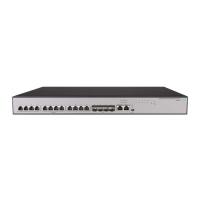236
Usage guidelines
The M flag in RA advertisements determines whether receiving hosts use stateful autoconfiguration
to obtain IPv6 addresses.
• If the M flag is set to 1 in RA advertisements, receiving hosts use stateful autoconfiguration (for
example, from an DHCPv6 server) to obtain IPv6 addresses.
• If the M flag is set to 0 in RA advertisements, receiving hosts use stateless autoconfiguration.
Stateless autoconfiguration generates IPv6 addresses according to link-layer addresses and
the prefix information in the RA advertisements.
Examples
# Set the M flag to 1 in RA advertisements to be sent.
<Sysname> system-view
[Sysname] interface vlan-interface 100
[Sysname-Vlan-interface100] ipv6 nd autoconfig managed-address-flag
ipv6 nd autoconfig other-flag
Use ipv6 nd autoconfig other-flag to set the other stateful configuration flag (O) to 1 in RA
advertisements to be sent.
Use undo ipv6 nd autoconfig other-flag to restore the default.
Syntax
ipv6 nd autoconfig other-flag
undo ipv6 nd autoconfig other-flag
Default
The O flag is set to 0 in RA advertisements. Hosts receiving the advertisements will acquire other
information through stateless autoconfiguration.
Views
Interface view
Predefined user roles
network-admin
Usage guidelines
The O flag in RA advertisements determines whether receiving hosts use stateful autoconfiguration
to obtain configuration information other than IPv6 addresses.
• If the O flag is set to 1 in RA advertisements, receiving hosts use stateful autoconfiguration (for
example, from a DHCPv6 server) to obtain configuration information other than IPv6
addresses.
• If the O flag is set to 0 in RA advertisements, receiving hosts use stateless autoconfiguration to
obtain configuration information other than IPv6 addresses.
Examples
# Set the O flag to 0 in RA advertisements to be sent.
<Sysname> system-view
[Sysname] interface vlan-interface 100
[Sysname-Vlan-interface100] undo ipv6 nd autoconfig other-flag

